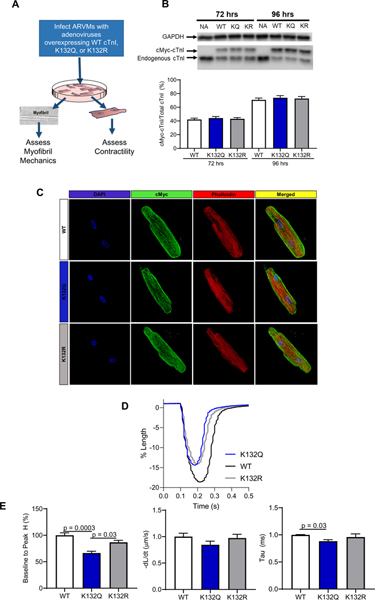Fig. 3.

ARVMs infected with K132Q cTnI demonstrate shorter duration of relengthening and decreased shortening. A. Schematic illustrating the experimental design. B. Representative blot and quantification of expression of cTnI constructs in ARVMs. Exogenous WT, K132Q, and K132R cTnI expression was 75% greater than endogenous cTnI expression 96 h after infection [n = 4 ARVM experiments]. C. ARVMs stained with anti-cMyc and fluorescently labeled-phalloidin demonstrate incorporation of cMyc tagged constructs into the ARVM sarcomere. [n = 4 ARVM experiments]. D. Representative trace of cell shortening of ARVMs expressing WT, K132Q, or K132R. Baseline of each trace was normalized to 1. E. ARVMs expressing K132Q cTnI have decreased peak height of contraction compared to ARVMs expressing WT cTnI (p = .0003) and ARVMs expressing K132R cTnI (p = .03). There is no significant change in rate of contraction of ARVMs expressing WT, K132Q, or K132R. ARVMs expressing K132Q cTnI have a faster exponential decay time constant (representing the speed of relaxation) than ARVMs expressing WT cTnI (p = .03). Statistical analyses of normal data were assessed by one way ANOVA with Sidak’s multiple comparison test. [3 ARVM experiments; WT n = 1–2 plates per experiment, 8 cardiomyocytes per plate; K132Q n = 2 plates per experiment, 8 cardiomyocytes per plate; K132R n = 1 plate per experiment, 8 cardiomyocytes per plate].
